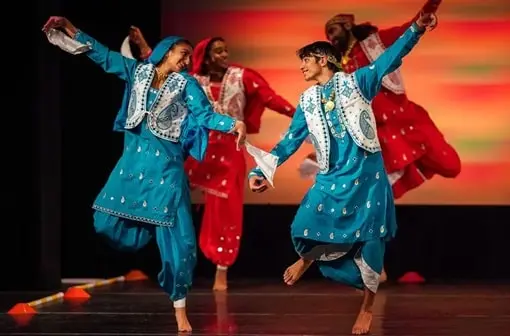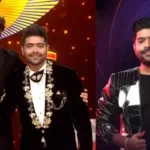The vivacity and exuberance of Punjab speaks for the state’s great cultural heritage. The music and dance forms of Punjab come with the essence of the soil. Each dance form offers a vibrant touch of nativity. Understanding the Punjabi way of life, its values become easier for those who understand the value of these dances. At the religious and social occasions, these dances brighten the time, make the moments special.
Bhangra

Bhangra, a global icon, represents Punjab’s energy. This colorful Punjabi dance type is rich in heritage and celebration. Harvest season saw bhangra performed to celebrate plentiful harvests and agricultural achievement. Fire and vigor abound in Punjabi dancing. To the Punjabi dhol drum, dancers perform rhythmic footwork, exhilarating leaps, and acrobatic movements. The dhol’s hammering rhythm and enthusiastic dancing make it impossible not to join in and exult.
Colourful bhangra is amazing. Dancers appear regal in colorful robes and turbans. Fluid kurtas and colorful scarves reflect the dance’s intensity. Despite its beginnings, bhangra developed. Modern elements like hip-hop and global dance have blended in. This blend of influences has generated a new Bhangra that honors its heritage and modern sensibilities. Bhangra’s history and originality make it relevant worldwide.
Giddha
Giddha, the female version of Bhangra, shows Punjabi women’s elegance and expression. This traditional Punjabi dance form honors femininity and portrays love, friendship, and everyday life stories. Only Punjabi ladies do that. In central Giddha, a group of women celebrates their heritage. They dress in Punjab’s bright hues to seem gorgeous. Traditional Punjabi clothes with intricate decorations and vibrant colors express the dance’s soul.
Beautiful and rhythmic Giddha contrasts with chaotic Bhangra. As they dance to Punjabi “Bolis,” their faces display various emotions. Boli songs are witty, hilarious, and profound. In the Bolis, women tell stories, anecdotes, and societal critique, engaging the audience. The dance’s complexity is augmented by rhythmic hand and foot clapping. Dancers’ graceful twirls and synchronized movements show how music, dance, and culture are linked. Giddha enables women express themselves, share stories, and celebrate their uniqueness beyond movements. The dance form helps women network, connect, and appreciate their culture beyond art. This platform fosters kinship among women. Giddha circles encourage dance, conversation, laughter, and life teachings. It commemorates Punjabi women’s strength, femininity, and togetherness.
Sammi
Punjab’s other cultural gem, Sammi, is a love and unity dance. Love and pleasure are shown in this Punjabi traditional dance during weddings and other pleasant celebrations. Little Sammi’s story is poetic. Dance and song express her love, passion, and sincere sentiments. Two lines of women sing and dance together, creating a beautiful spectacle. Colorful Sammi outfits accompany their dancing. The performance requires elaborately embroidered lehengas and cholis. These outfits look good and depict Punjabi culture.
Hand clapping, synchronized footwork, and lovely gestures make it joyous. Samantha’s dancers’ synchronicity and harmony express love and unity. Sammi is more than a dance in Punjabi culture—it represents love, harmony, and life’s greatest moments. Punjabi weddings and festivities need music to express love, desire, and family and community bonds.
Jhumar
Sandal Bar, Punjab’s jhumar is elegant, exciting, and culturally vibrant. This beautiful and elegant dance enhances special occasions. Jhumar dancers smoothly spin. This dance is enjoyable because dancers hold hands in a circle or semicircle. Punjabis value fraternity and community. Jhumar dance and Punjabi folk music compliment. Beautiful music makes the dancers swing smoothly. Because the songs honor love, life, and Punjab, the performance is culturally and emotionally engaging.
Jhumar looks better in the dancers’ extravagant outfits. Elegantly embroidered and sequined garments are lovely. These bright costumes accentuate the dance and commemorate Punjab’s rich dress tradition. The core of Punjabi joy is jhumar. Friendly and open, the region is famous.
Luddi
Luddi, Punjab’s cultural heritage, embodies youth. Weddings and other festivals include this vibrant Punjabi traditional dance celebrating life. Luddi celebrates brotherhood with a circle of dancers. Traditional Punjabi dress reflects their vibrant culture. Dancers wear brightly colored lehengas and cholis with intricate ornamentation to match the dance’s intensity. Luddi has fast feet and expressive gestures. Dancers spin swiftly to the rhythm and spin gracefully. These rapid rotations demonstrate ability and the dance’s fun. Dancers express life’s joy as they move freely. Luddi is a cheerful community dance. Punjabi harmony, togetherness, and pleasure are shown. Luddi’s energy and excitement are infectious. Punjabi culture celebrates life at every occasion, as seen by the dance. Luddi reminds us that Punjabi culture cherishes every moment, big or little. Punjabi culture incorporates life’s joys and festivities via luddi. The dance symbolizes Punjab’s generations-old pleasure and camaraderie.
Malwai Giddha
A stunning regional form of the renowned Giddha dance is found in Punjab’s culturally rich Malwa district. Only Punjabi women execute this aggressive dance form, which is similar to Giddha but has its own style and intensity, forming a beautiful tapestry of Punjab’s rich folk dance traditions. Giddha and Malwai Giddha include girls dancing in a circle and singing Punjabi “Bolis.” These classic Bolis show Punjabi folk music’s humor, comedy, and social criticism. Dance and music convey a stirring drama that engages audiences.
Malwai Giddha is special for its energy. Malwai Giddha dancers’ graceful dancing and hand motions convey the region’s spirit. The dance is distinctive because of dancers’ energy. Festivals and assemblies include Malwai Giddha, a cultural asset. These spaces let women to express themselves artistically, respecting their past and enhancing Punjabi dances. Malwai Giddha describes Malwa women’s history, traditions, and rich culture. Geographic variation reflects Punjab’s folk dances’ cultural diversity. All around Punjab, these renowned art forms are interpreted differently, enriching Punjabi culture. According to Malwai Giddha, Punjab’s diverse ethnicities encourage boundless creativity and expression.
Conclusion
The heartbeats of Punjab come visible with the dances. They are the colorful celebrations of the moments filled with culturally rich traditions. Be it the Bhangra dances with high energy or the Giddha dance full of grace, the dances are full of stories untold.
Santosh Kumar, the author behind IndiasStuffs.com, is passionate about sharing valuable insights on a variety of topics, including lifestyle, technology, and Indian culture.
Page Contents

